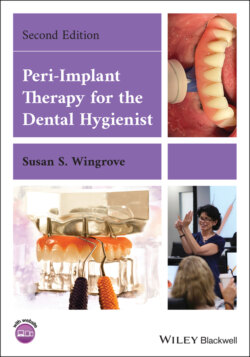Читать книгу Peri-Implant Therapy for the Dental Hygienist - Susan S. Wingrove - Страница 20
Orthodontic implants/temporary anchoring devices (TADs)
ОглавлениеTADs are titanium mini‐screws, used primarily by orthodontists. They are screwed directly into the bone through the gingiva to facilitate tooth movement and to anchor an orthodontic appliance. Once treatment is complete, the clinician can remove the TAD without trauma or need for bone grafting.
TADs are placed in adolescents to adults and used on an average of 6–12 months. Primarily used for stabilization and to assist in tooth movement without stressing the surrounding teeth. Also, used to force eruption of impacted canines or misaligned teeth, or to stabilize an appliance (14).
Hygienist’s role is to identify TAD patients, monitor, and treat to eliminate the biofilm and prevent soft tissue inflammation. Be aware, TAD implants may be located in the sulcus or palate of the orthodontic patients. Give patients the tools (i.e., sulcus or end tuft brushes), antimicrobial rinse, and other recommendations to eliminate the oral biofilm. Biofilm will accumulate on these TADs and can prevent the success of the orthodontic treatment as well as the overall oral hygiene of the patient. TADs are a tool in the toolbox for orthodontist to enable teeth to be moved in especially noncompliant patients with good oral hygiene as the KEY, see Chapter 8 for more recommendations on at‐home‐care.
Zygoma implants (Figure 1.16), also referred to as zygomatic implants, are longer than regular implants, initially developed by Brånemark in the 1980s. They are usually recommended to stabilize fixed full‐arch final prosthesis in maxillary jaw, in cases where severe bone resorption is present in the maxilla. They are longer than regular dental implants; they extend up to 55 mm, compared with 10–15 mm. Zygomatic implants penetrate through the maxillary sinus and anchor in the very dense zygomatic bone. The head of the fixture normally emerges in a slightly palatal position in the second premolar/first molar area of the maxilla. The advantage to this choice of treatment is for patients with insufficient bone quality who may not be good candidates for traditional implant treatment or traditional dentures because of the high level of bone resorption. This can allow these patients durable, long‐lasting, stable implant‐supported fixed final prosthesis without additional bone grafting procedures.
There are many styles and types of dental implants that have been placed and are currently being placed on the market today. Their use is determined by the type of bone available and the prosthesis needed to accomplish the treatment. Implant systems have been developed by different manufactures with a variety of component parts, but there are primary components that are generally used.
